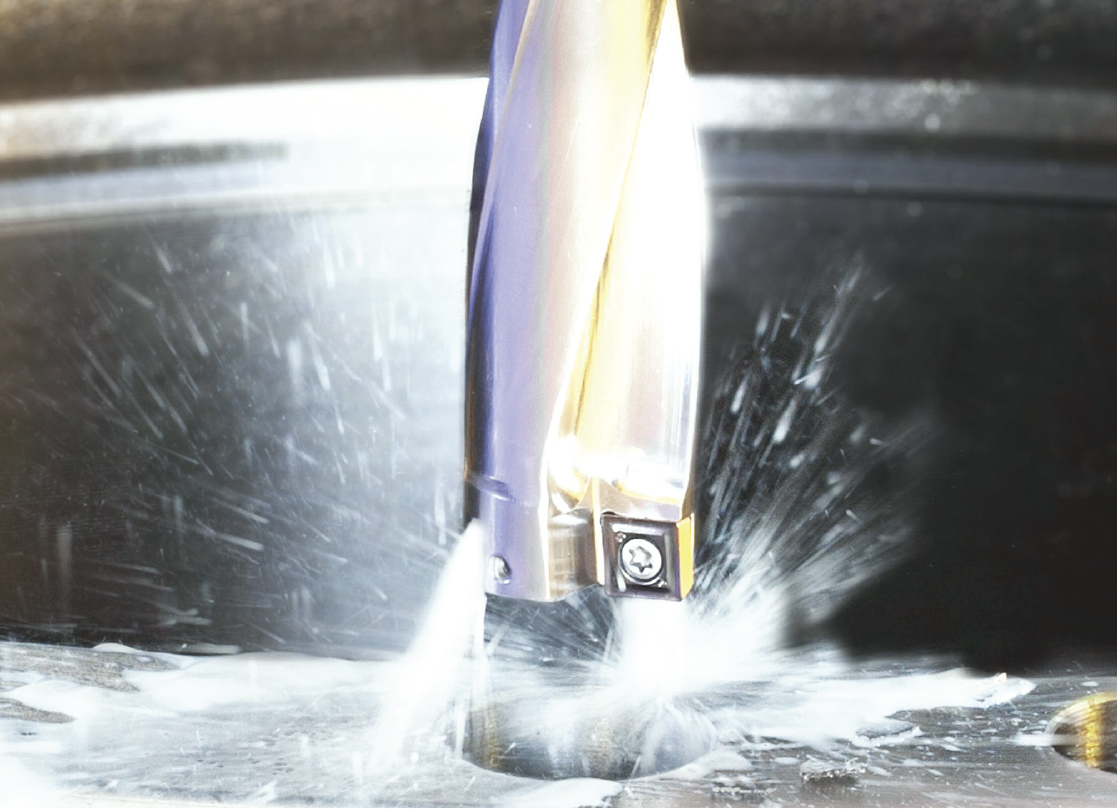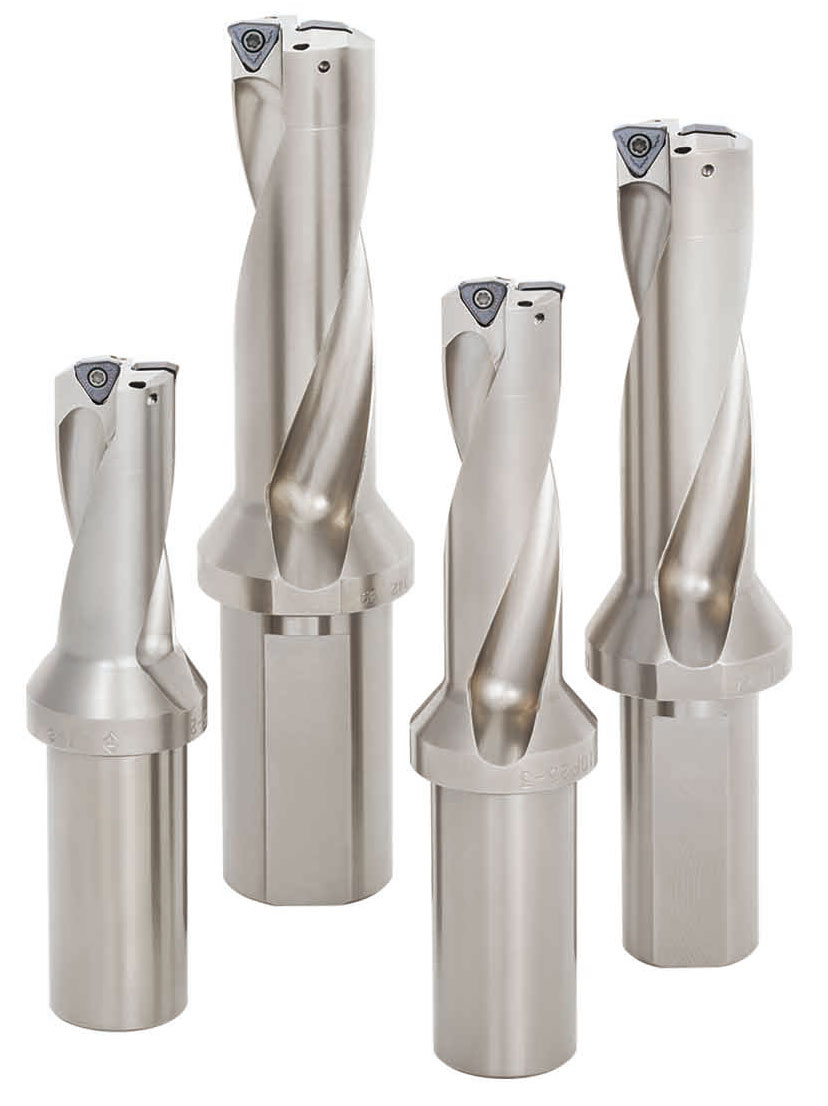by Kip Hanson
Avoiding catastrophe when using indexable insert drills
There’s a chunk of 4140 steel alloy sitting on my office floor, an indexable insert drill sticking out one end. My coworkers painted it with red and green stripes and presented it to me for Christmas one year, a souvenir of the day I pushed my CNC lathe a bit too hard, thus welding the drill forever within the steel. I use it for a doorstop.
Bears and big blocks
If I’d paid better attention to what I was doing that day, the doorstop event (and the unpleasant discussion with my boss afterwards) could have been avoided. There are many failure modes with indexable insert drills, any of which can cause broken or seized drills, rotten tool life, scrap parts, and more.
One issue is poor chip evacuation. Michael Hunter, business development manager for tooling provider Komet of America Inc., says you have to listen to the tool. “It should sound like a big block Chevy, nice and smooth. If it’s making rumbling noises, or growling like a bear, you’re not getting good chip evacuation.”
Hunter says it doesn’t take much to go from a clean, accurate hole to a drill that’s welded itself to the workpiece. Getting things running right might take only a 10 per cent adjustment to the feed rate or rpm, or switching to a different chip breaker or carbide grade. But knowing what steps to take requires a good understanding of the do’s and don’ts of hole drilling. “Education is key,” he says. “Much of the responsibility for this falls to us as tooling providers, training the users the best way to run an indexable drill.”
John Mitchell, general manager for Tungaloy America in Canada, says another issue associated with chip evacuation is chip formation.
“The optimal chip produced on the centre cutting insert is a small continuous coil, where the optimal chip formation on the periphery insert is the form of a “C” or a “6”. The TungSix drill does this by having a chipbreaker on the centre cutting side of the insert that produces the desired coil chip formation and a different chip breaker on the periphery cutting insert that produces “C” and “6”s. One insert has two different chip-breakers that cannot be mis-loaded.”
Hunter suggests another thing that may have doomed my drill: insufficient power. Drilling operations typically require substantial Z axis thrust, and insert drills are no exception. Spindle torque can become a limiting factor as well, especially on larger drills—go much above 75 mm (3 in.) and many CNC machine tools simply aren’t up to this gargantuan holemaking task. This makes it important to compare the machine specifications to the drill’s torque requirements before undertaking any drilling operations.
Straight and true
Good machine maintenance is also important. If you’re having accuracy or tool life problems when drilling on a CNC lathe, check for drag marks in the hole. This is usually a sign the turret has been bumped, or the machine crashed hard enough to jar the spindle out of whack. Hunter recommends clamping a piece of centreless ground rod the same length as the drill in the turret block, then using a spindle-mounted dial indicator to sweep the length of the rod in each axis, and swing around the diameter at each end. If the rod doesn’t run true, there’s little chance of successful drilling.
 David Vetrecin, holemaking product manager for Iscar Canada, says this is probably the biggest challenge when drilling on a lathe. “Look for rub marks on the drill body. This is a good indication the turret isn’t lined up properly, which can cause the drill to cut oversize or even slightly undersize, depending on the direction of misalignment.”
David Vetrecin, holemaking product manager for Iscar Canada, says this is probably the biggest challenge when drilling on a lathe. “Look for rub marks on the drill body. This is a good indication the turret isn’t lined up properly, which can cause the drill to cut oversize or even slightly undersize, depending on the direction of misalignment.”
Hole drilling operations on a machining centre suffer many of the same challenges as on a CNC lathe, but alignment is usually not one of them. That doesn’t necessarily make drilling any easier. “Chip evacuation is more difficult on a vertical machining centre than it is on a lathe,” Vetrecin says. “The chips must travel up and out of the hole, and many machining centres aren’t equipped with through the spindle coolant, so chip packing is often the biggest problem we see here.”
Vetrecin cites Iscar’s HD chipbreaker for drilling low carbon steel as an example of how a drill can overcome this problem. Part of the DR-Twist indexable drill series, the new chipformer eliminates long curly chips that result from machining low carbon steel by cutting the material into short chips that are then evacuated easily along the flutes.
High pressure cutting fluid is the rule with any hole drilling operation, but especially so in this case. Vetrecin recommends 1000 psi or more and using clean, properly mixed cutting fluid. He says one of his customers was able to double tool life by going from a 500 psi pump to one with 1500 psi. He says it’s also a good idea to use a cutting fluid with extreme pressure (EP) additives, especially when drilling high temp alloys and stainless steel.
“And keep an eye on the spindle load,” says Vetrecin. “It should remain constant through the entire hole length. If the spindle load spikes or jumps up and down then you have a chip evacuation problem. If it gradually gets higher after a number of holes, the tool is starting to wear. Things go wrong quickly when drilling, so document your process and be sure to change the inserts before catastrophe strikes.”
One size doesn’t fit all
One of the most common failure modes in indexable drilling is “that the centre of the drill is at zero surface feet per minute,” says Mitchell. It means the insert isn’t cutting, but instead, pushing the material away.
“Conventional indexable drills try to accomplish this by using the weakest part of the positive insert, where the relief angle meets the top surface of the insert. This explains why the centre cutting insert is so prone to chipping and breakage. Whereas the TungSix drill, a positive insert that allows for the economy of double sided inserts, uses the obtuse corner, or strongest part of the insert at the centre, preventing chipping and breakage. This dramatically extends tool life and improves performance.”
 According to Mitchell, the product is unique: when the insert is flipped over, the obtuse angle becomes the relief angle, providing a double sided positive insert.
According to Mitchell, the product is unique: when the insert is flipped over, the obtuse angle becomes the relief angle, providing a double sided positive insert.
He says that since the obtuse corner must fit into a “dovetail” pocket, “it provides additional rigidity. Conventional positive inserts rely solely on a small insert screw to prevent movement, where the TungSix drill has high rigidity because of the dovetail locking mechanism.”
Sandvik Coromant product and application specialist Randy McEachern adds that the peripheral, or outboard insert, is also subject to failure. “Plastic deformation can occur on the outer corner of the peripheral insert when the cutting speed is too high or too ‘soft’ of a carbide grade is used. Reduce the speed or choose a more heat resistant one to extend tool life. At the other end of the spectrum is built up edge (BUE), which is common on low carbon and stainless steels. This occurs when the material being cut adheres to the coating on the insert. It’s easy to identify unless the build up pops off, making it look like a chipped edge. If you suspect BUE, your best bet is to increase the cutting speed and/or change to a more positive insert geometry.”
For 300-series stainless steels, titanium, and heat resistant super alloys (HRSA) such as Super Duplex or Inconel, McEachern recommends a tool like the CoroDrill 880 with insert grades GC1144 (optimized for central) and GC2044 (optimized for peripheral inserts), which has a new PVD oxide coating for “excellent wear resistance and resistance against built up edge in all types of stainless steels and HRSA. These grades are matched with a sharp cutting edge geometry, which supports free cutting action and wear resistance.” He suggests an emulsion-based cutting fluid mixed to a level of 13 per cent concentration for added lubricity, and a “positive feed rate” to prevent the drill from causing work hardening in the hole.
Proactive tooling maintenance is another step on the road to productive drilling. Pockets that aren’t perfectly clean, and damaged seats and screws allow the insert to shift during the cut, leading to chipping or breaking. Always use
the shortest tool possible, he says, and be sure to perform test cuts up front to optimize chip control and develop good cutting data before going into production.
“A lot of shops just use whatever drill and inserts are available,” says McEachern. “Sometimes they’ll get away with it, but they might not be able to run as fast as they normally would with a shorter drill, or obtain the tool life they should. It just depends how many holes they have to drill. For any sort of production volume, it behooves a shop to fine tune the process.”
Indexable insert drills aren’t a one-size-fits-all proposition. You might start with a general-purpose insert, but move to a harder grade if the tool is wearing prematurely, or a more rugged geometry—one with a negative rake, perhaps, or a rounded edge—if chipping is a problem. This increases cutting forces, however, creating a delicate balance between available machine power, chip control, tool life, and productivity.
There are plenty of options out there. When in doubt, contact your cutting tool supplier. Take good notes, and don’t be afraid to push the drill beyond manufacturer’s recommended speeds and feeds. Just be forewarned: you might receive an indexable insert drill doorstop for your next birthday present. SMT
